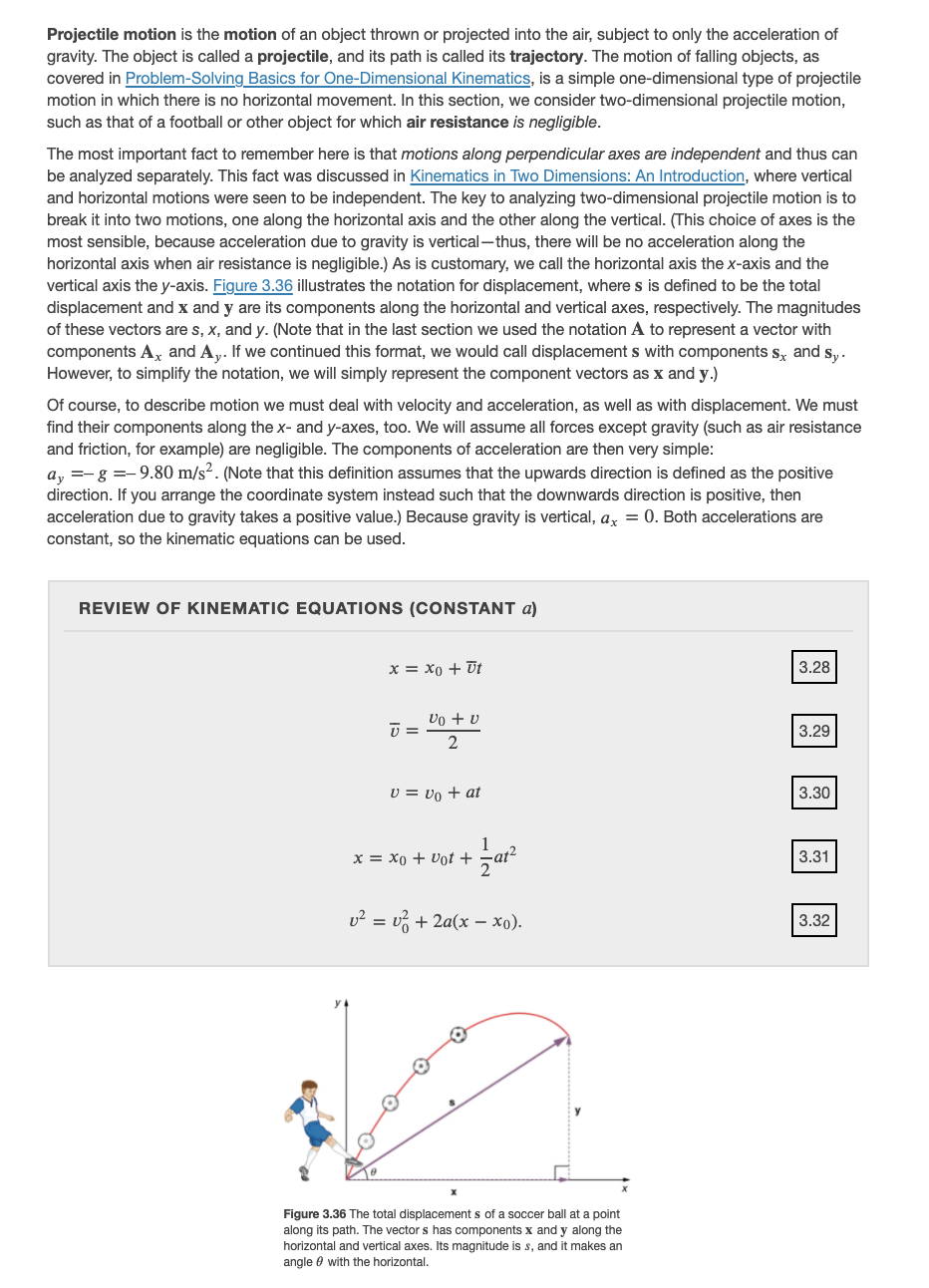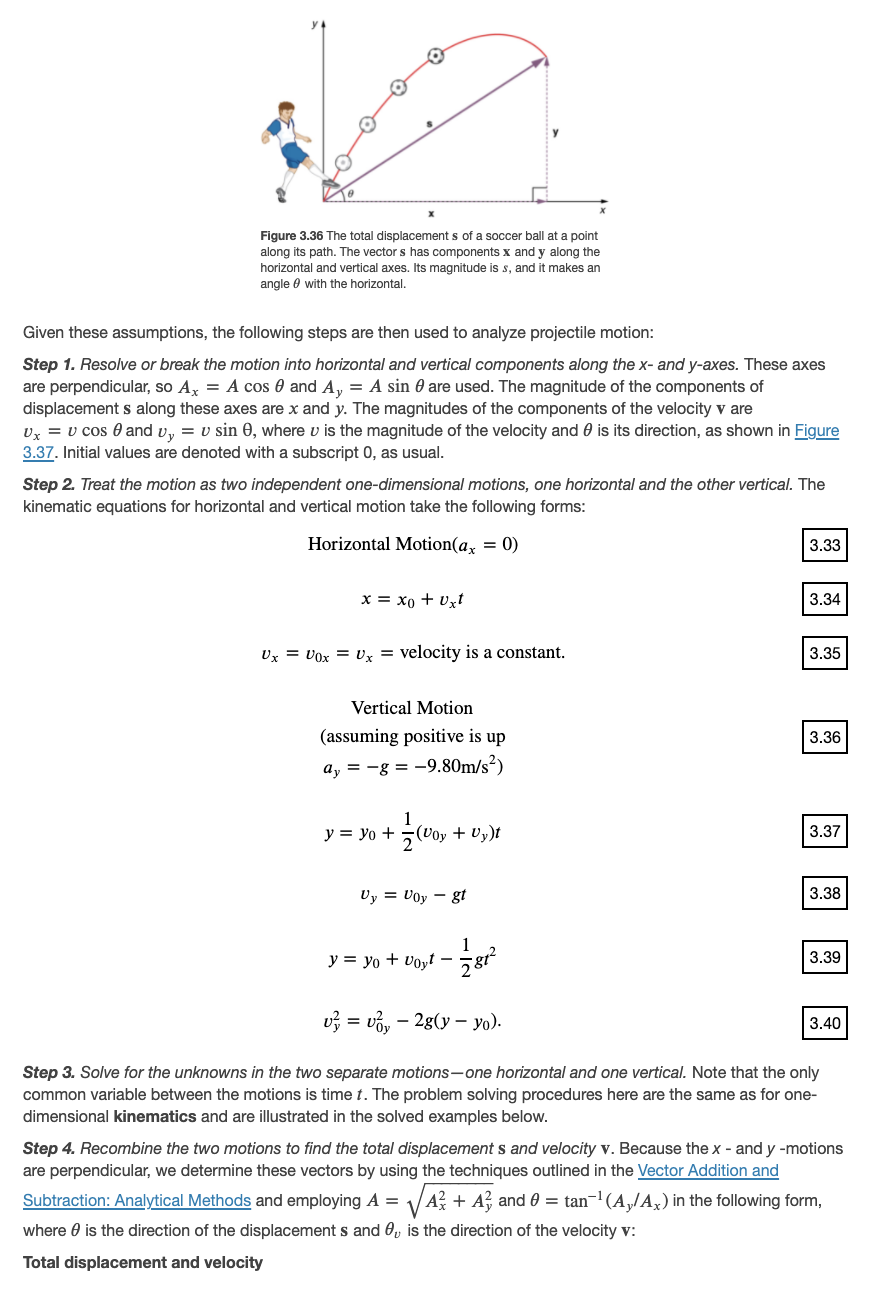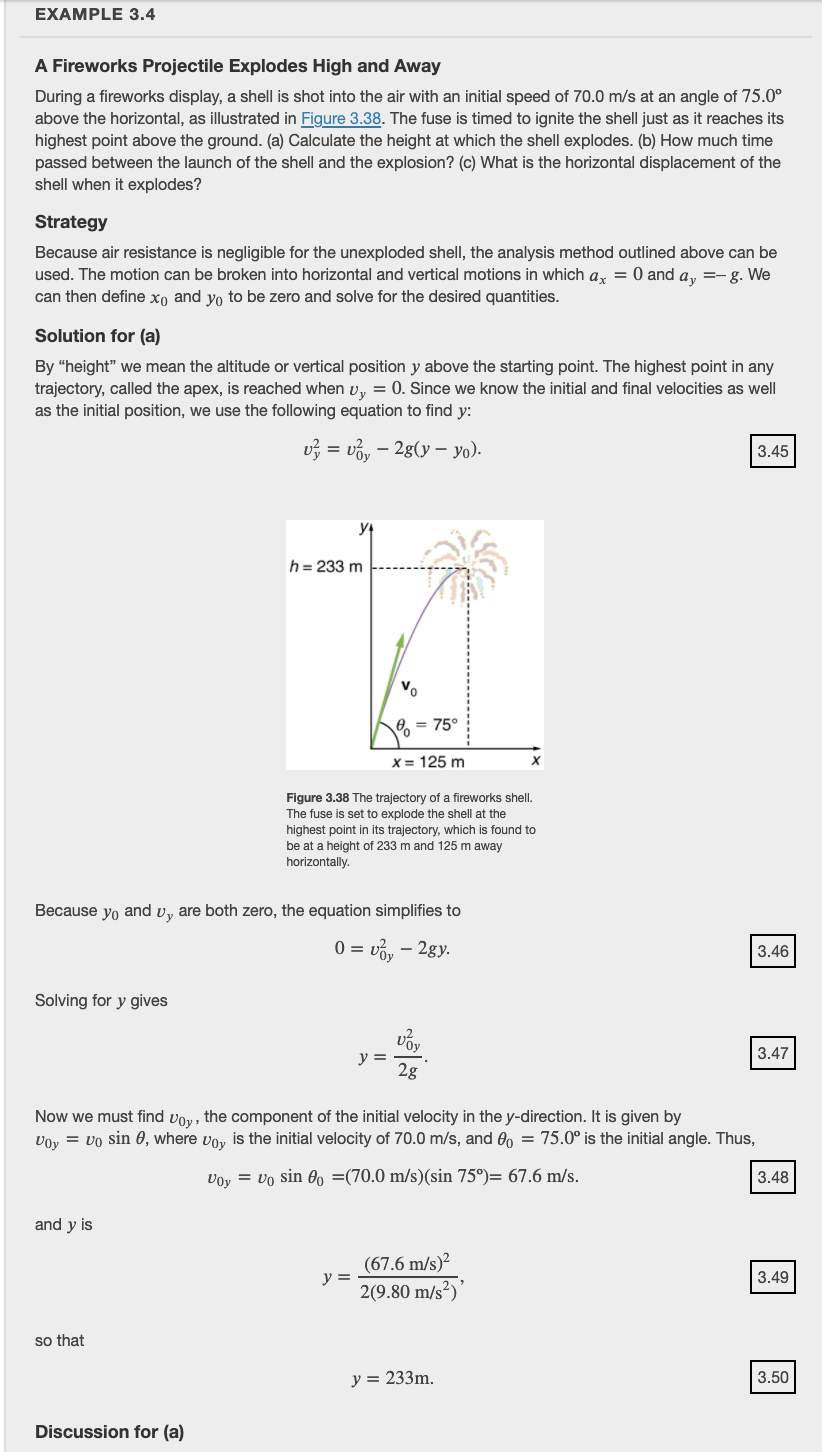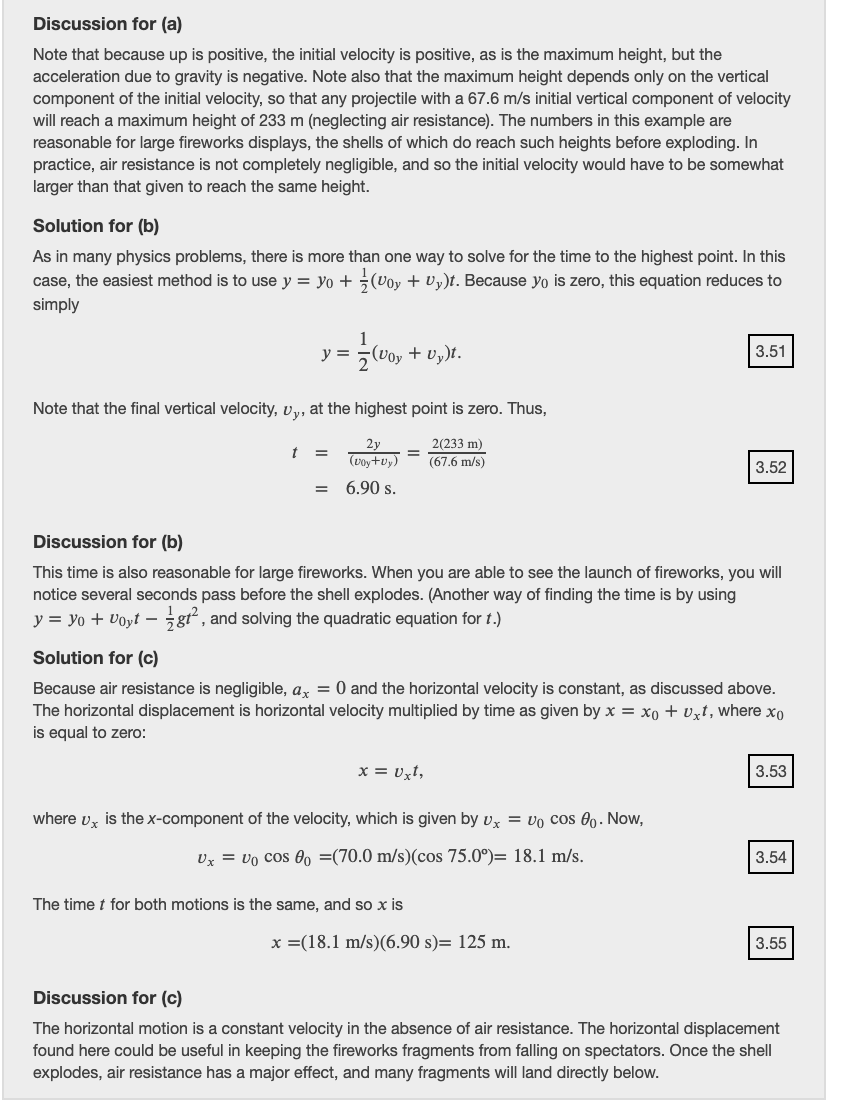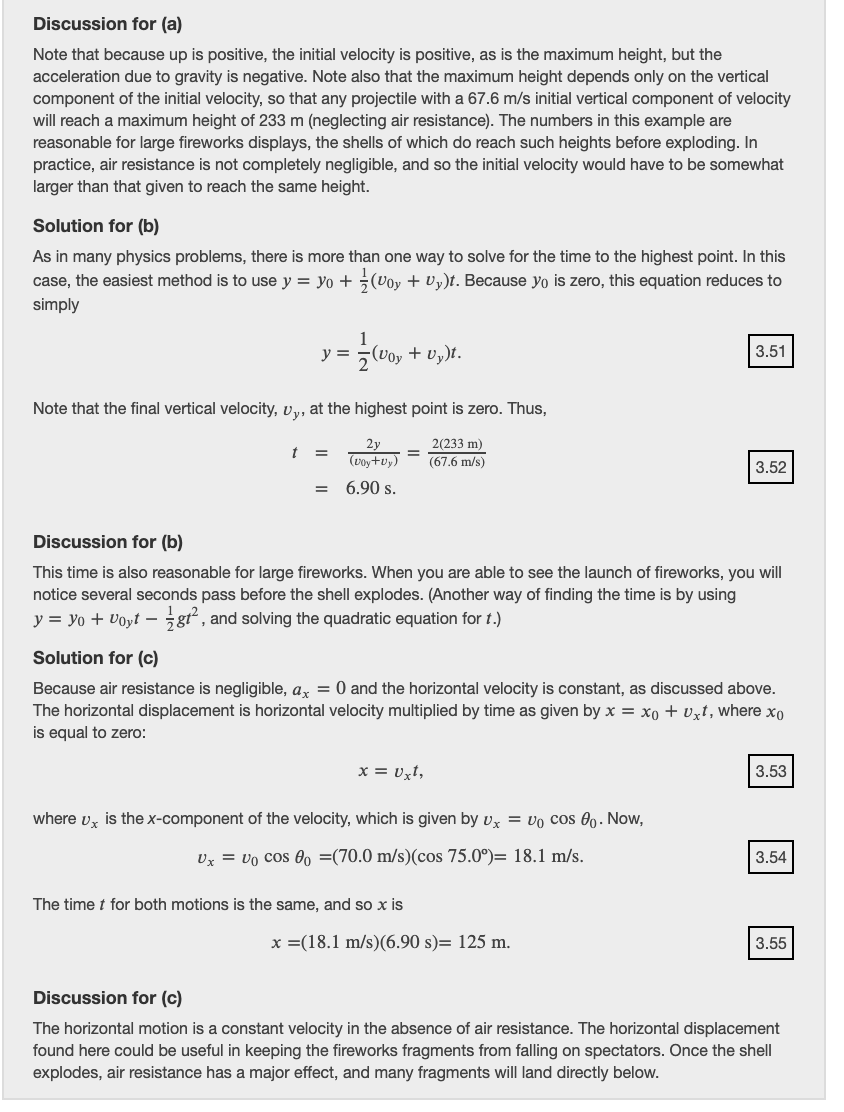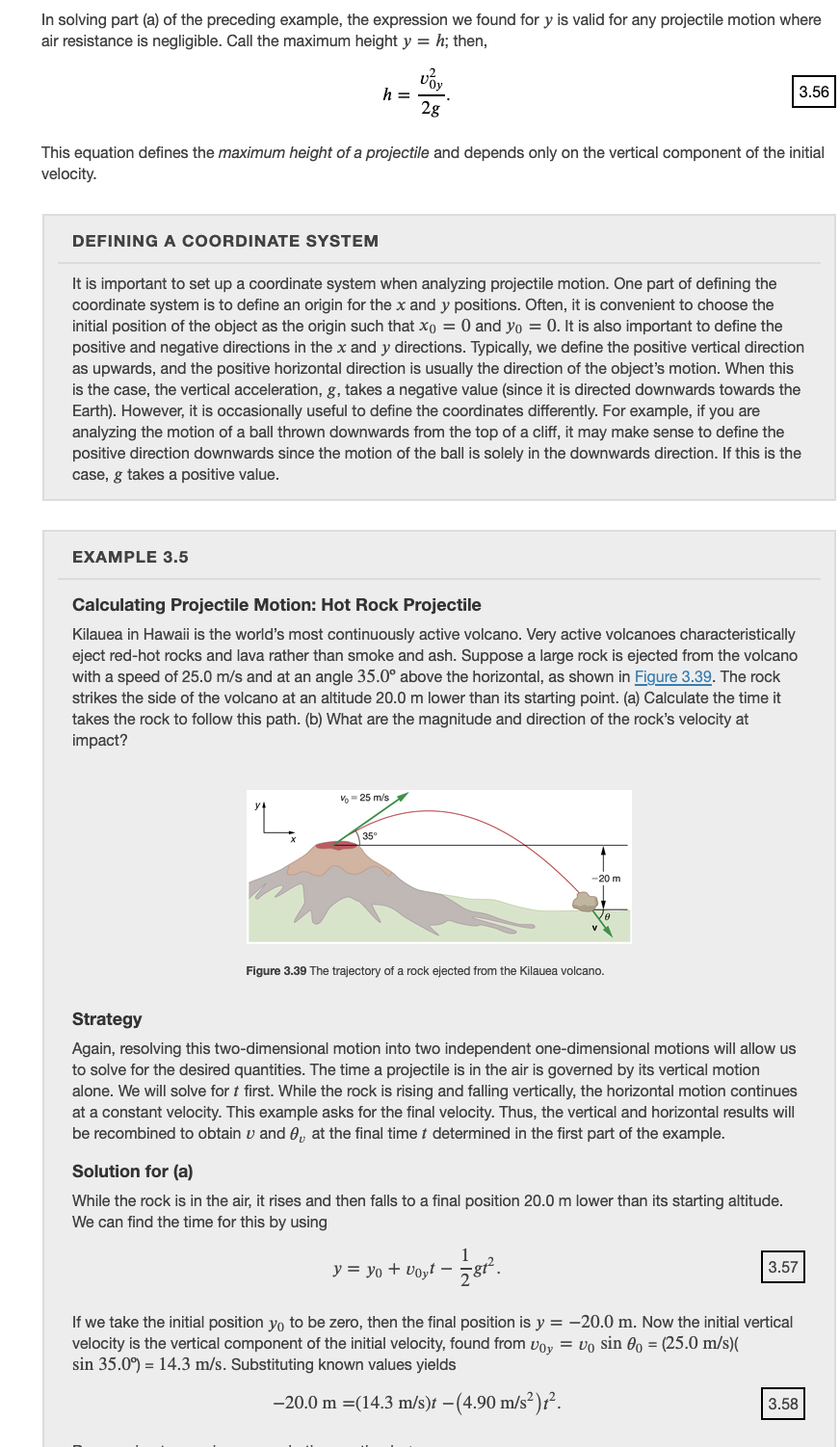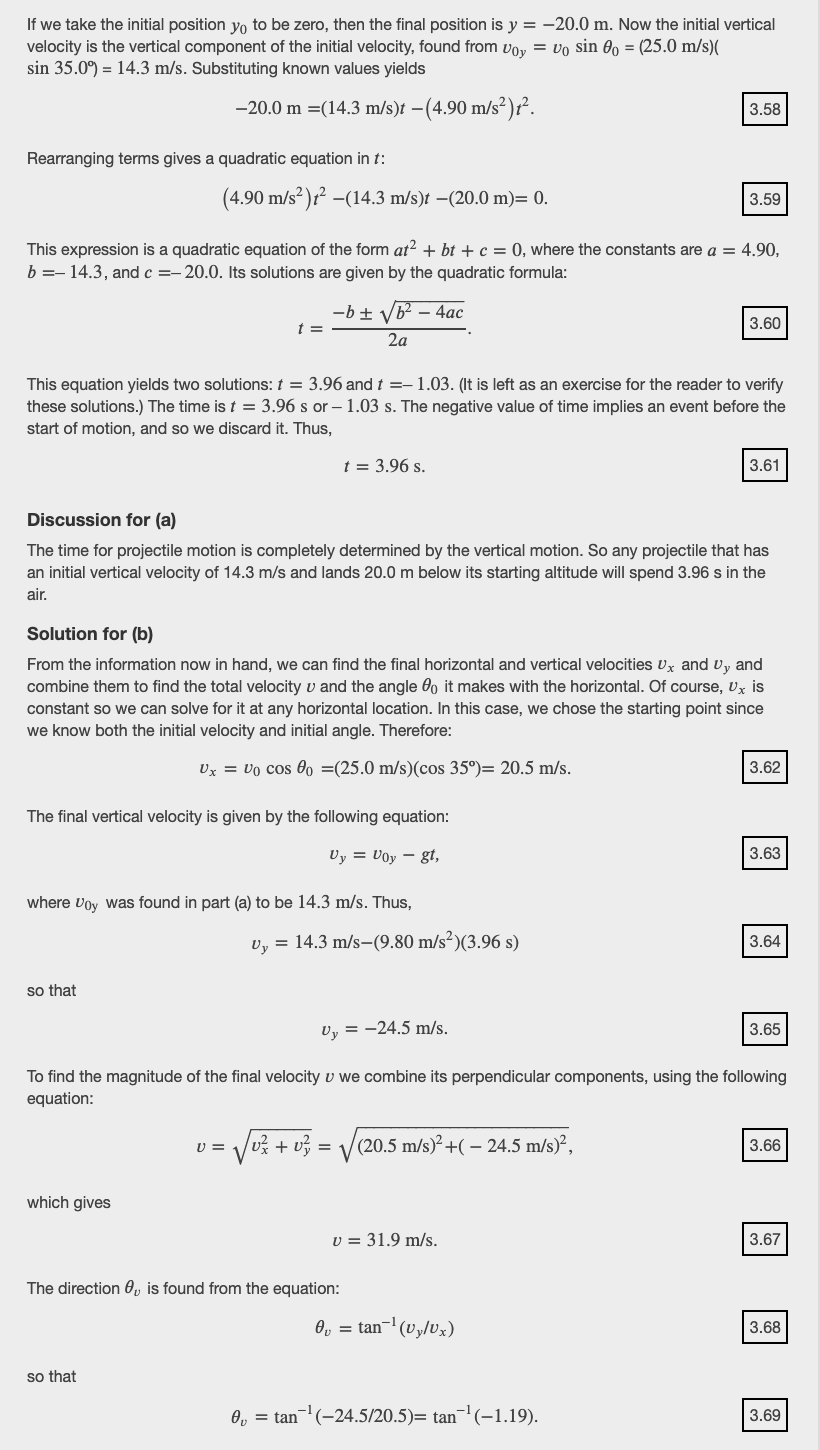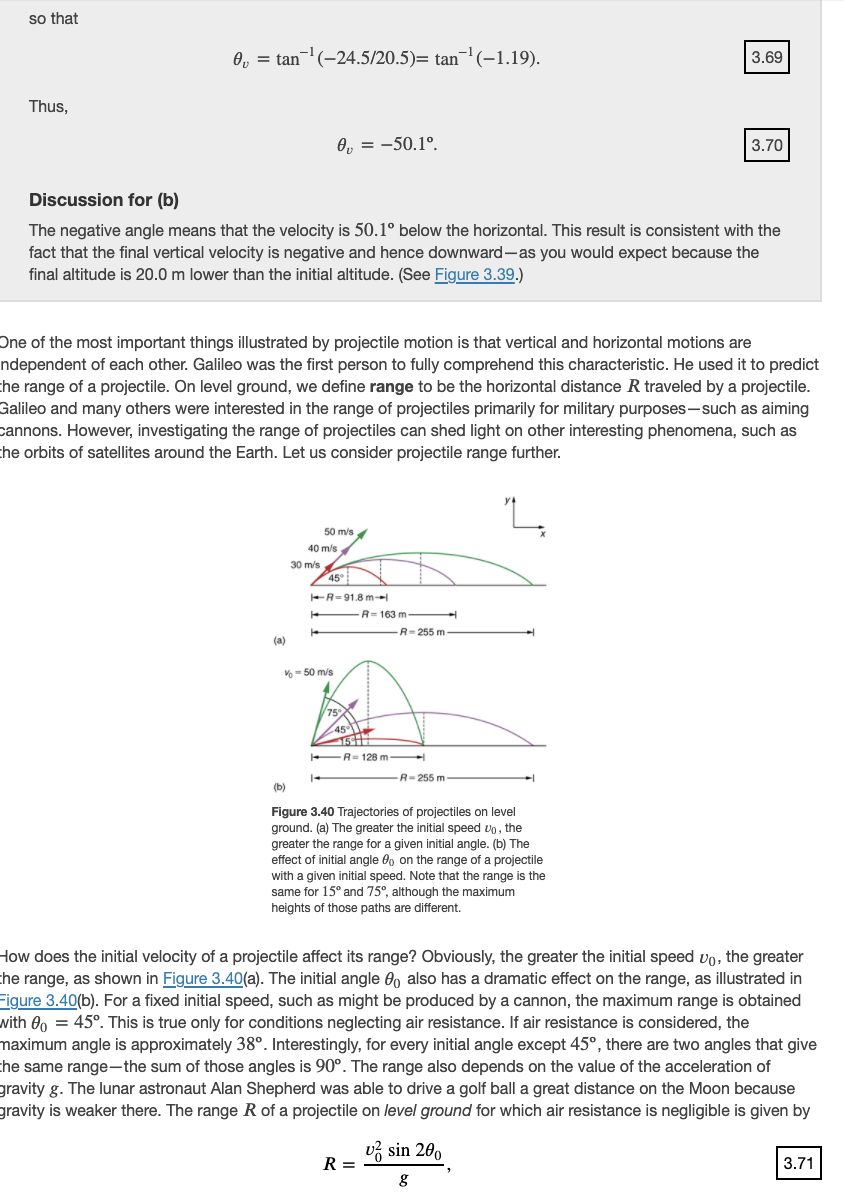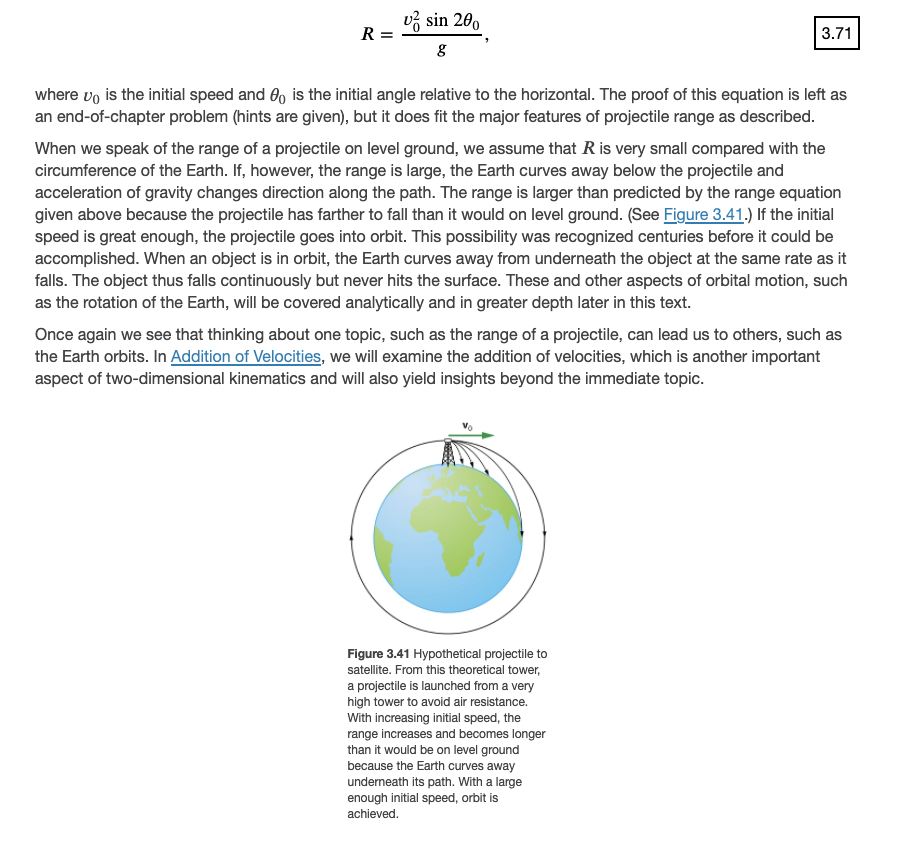Please help!
3.4 Projectile Motion
27.A ball is thrown horizontally from the top of a 60.0-m building and lands 100.0 m from the base of the building. Ignore air resistance.
(a) How long is the ball in the air?
(b) What must have been the initial horizontal component of the velocity?
(c) What is the vertical component of the velocity just before the ball hits the ground?
(d)What is the velocity (including both the horizontal and vertical components) of the ball just before it hits the ground?
28. (a)A daredevil is attempting to jump his motorcycle over a line of buses parked end to end by driving up a 32 ramp at a speed of 40.0 m/s (144 km/h) . How many buses can he clear if the top of the takeoff ramp is at the same height as the bus tops and the buses are 20.0 m long?
(b) Discuss what your answer implies about the margin of error in this actthat is, consider how much greater the range is than the horizontal distance he must travel to miss the end of the last bus. (Neglect air resistance.)
29. An archer shoots an arrow at a 75.0 m distant target; the bull's-eye of the target is at the same height as the release height of the arrow.
(a)At what angle must the arrow be released to hit the bull's-eye if its initial speed is 35.0 m/s? This part of the problem, explicitly shows how you follow the steps involved in solving projectile motion problems.
(b)There is a large tree halfway between the archer and the target with an overhanging horizontal branch 3.50 m above the release height of the arrow. Will the arrow go over or under the branch?
37.Serving at a speed of 170 km/h, a tennis player hits the ball at a height of 2.5 m and an angle below the horizontal. The base line is 11.9 m from the net, which is 0.91 m high. What is the angle such that the ball just crosses the net? Will the ball land in the service box, whose service line is 6.40 m from the net?
Projectile motion is the motion of an object thrown or projected into the air, subject to only the acceleration of gravity. The object is called a projectile, and its path is called its trajectory. The motion oi falling objects. as covered in Problem-Solving Basics for One-Dimensional Kinematics, is a simple one-dimensional type of projectile motion in which there is no horizontal movement. In this section. we consider two-dimensional projectile motion, such as that of a iootball or other object tor which air resistance is negligible. The most important fact to remember here is that motions along perpendicular axes are independent and thus can be analyzed separately. This fact was discussed in Kinematics in Two Dimensions: An Introduction, where vertical and horizontal motions were seen to be independent. The key to analyzing two-dimensional projectile motion is to break it into two motions, one along the horizontal axis and the other along the vertical. {T his choice oi axes is the most sensible, because acceleration due to gravity is verticalthus, there will be no acceleration along the horizontal axis when air resistance is negligible} As is customary. we call the horizontal axis the x-axis and the vertical axis the yaxis. gure 3.36 illustrates the notation for displacement. where s is defined to be the total displacement and x and y are its components along the horizontal and vertical axes, respectively. The magnitudes oi these vectors are s. x, and y. {Note that in the last section we used the notation A to represent a vector with components Ax and A,,. If we continued this format, we would call displacement s with components 5ch and sy. However, to simplify the notation, we will simply represent the component vectors as x and y.} Oi course, to describe motion we must deal with velocity and acceleration, as well as with displacement. We must find their components along the x and yaxes too. We will assume all forces except gravity (such as air resistance and friction, ior example] are negligible. The components oi acceleration are then very simple: a3. = g = 9.80 misz. (Note that this deiinition assumes that the upwards direction is dened as the positive direction. If you arrange the coordinate system instead such that the downwards direction is positive. then acceleration due to gravity takes a positive value.) Because gravity is vertical. ox = 0. Both accelerations are constant, so the kinematic equations can be used. REVIEW OF KINEMATIC EQUATIONS {CONSTANT a) x=xB+EI _ \"n+0 U: 2 v=vo+ot 1 x=xo+vor+3ar2 @EEEE u2=u+2a(xx0). Flglre 3.38 The total displacements of a soccer ball at a point along its path. The vector 5 has components It and y along the horizontal and vertical axes. Its magnitude is s, and it makes an angle 9 with the horizontal. .- K Flylre 3.36 The total olsplacement s at a soccer ball at a point along its path. The vector 5 has components It and y along the horlzontal and vertlcal axes. Its magnitude is .r, and it makes an angle 9 with the horlzontal. .- K Given these assumptions. the following steps are then used to analyze projectile motion: Step 1'. Flesoive or break the motion into horizontal and vertical components along the x and y-axes. These axes are perpendicular. so Ax = A cos 3 and A}, = A sin 6' are used. The magnitude of the components of displacement 5 along these axes are x and y. The magnitudes of the components of the velocity v are ox = tr cos 9 and y = v sin 9, where v is the magnitude of the velocity and 6' is its direction. as shown in g 3.37. Initial values are denoted with a subscript D, as usual. Step 2. Treat the motion as two independent one-dimensional motions, one horizontal and the other vertical. The kinematic equations for horizontal and vertical motion take the following forms: Horizontal Mol;ion{.srJ|c = 0} x = x0 + 0x! ox = n.0,: = nJ|r = velocity is a constant. Vertical Motion (assuming positive is up a, = g = 9.80mr'52} 1 y = so + away + by): v}. = no, gr 1 1-338 y=yo+voy v2}: = 0%,, 230' 3'0)- E @E@ 3 .37 Step 3. Solve for the unknowns in the two separate motionsone hon'zontai and one vertical. Note that the onlyr common variable between the motions is time i. The problem solving procedures here are the same as for one- dimensional kinematics and are illustrated in the solved examples below. Step 4. Flecombine the two motions to nd the total displacement s and velocity v. Because the x - and y -motions are perpendicular. we determine these vectors by using the techniques outlined in the Vector Addition and Subtraction: Analytical Methods and employing A = \"A; + A; and I9 = tan"1 (Ayr'Ax) in the following form, where 3 is the direction of the displacement s and 3\" is the direction of the velocity v: Total displacement and velocity Subtraction: Analytical Methods and employing A = x/Ai + A3 and I9 = tan1(Ayl'Ax) in the following form, where 3 is the direction of the displacement s and 30 is the direction of the velocity v: Total displacement and velocity 5: 33+}:2 B=tan_l(yfx) v: v+v "???%'fffff on O v 0 (any: I \"'0' It? it? v? . 'i 9 |"'r: t 9 \".5 6 Figure 3.37 [at We analyze twodimensional projectile motion by breaking It Into two independent onedimensional motions along the vertical and horizontal axes. (in) The horizontal motion ls simple. because ax = 0 and 01 is thus constant. (c) The velocity In the vertical direction begins to decrease as the object rises; at its highest point, the vertical velocity Is zero. As the object falls towards the Earth again' the vertical velocity Increases agaIn In magnitude but points In the opposite direction to the Initial vertical velocity. {d} The x and y mot|cns are recombined to give the total velocity at any given po'nt on the trajectory. EXAMPLE 3.4 A Fireworks Projectile Explodes High and Away During a reworks display. a shell is shot into the air with an initial speed of 70.0 m/s at an angle at 75.0\" above the horizontal, as illustrated in gure 3.38. The fuse is timed to ignite the shell just as it reaches its highest point above the ground. [a] Calculate the height at which the shell explodes. [b] How much time passed between the launch of the shell and the explosion? [c] What is the horizontal displacement of the shell when it explodes? Strategy Because air resistance is negligible tor the unexploded shell, the analysis method outlined above can be used. The motion can be broken into horizontal and vertical motions in which ox = 0 and ay = 3. We can then dene x0 and yo to be zero and solve for the desired quantities. Solution for {a} By \"height\" we mean the altitude or vertical position y above the starting point. The highest point in any trajectory, called the apex, is reached when u}, = 0. Since we know the initial and nal velocities as well as the initial position, we use the following equation to nd y: ya = U3, 230v yo). h=233m x=125rn X Flute 3.30 The treJeotory of a reworks shell. The fuse is set to explode the shell at the highest point In Its traJeotory. which Is found to beat aheightot233 m and 125 mewsy horizontaliy. Because yo and v}, are both zero, the equation simplies to 0 = 0% 23y. Solving tor y gives 2 \"y = . 3.47 23 y Now we must nd any , the component at the initial velocity in the ydirection. It is given by v.31. = no sin 9, where cm is the initial velocityof 70.0 mis, and 90 = T10\" is the initial angle. Thus, on}. = no. sin 6.} =(70.0 mfs)(sin T5\"): 67.6 1113's. andyis y _ (67.6 mislg 2(9.30 W52), so that y = 233m. Discussion for {a} Discussion for (a) Note that because up is positive, the initial velocity is positive, as is the maximum height, but the acceleration due to gravity is negative. Note also that the maximum height depends only on the vertical component of the initial velocity, so that any projectile with a 67.6 mls initial vertical component of velocity will reach a maximum height of 233 m (neglecting air resistance). The numbers in this example are reasonable for large reworks displays, the shells of which do reach such heights before exploding. In practice, air resistance is not completely negligible, and so the initial velocity would have to be somewhat larger than that given to reach the same height. Solution for {b} As in many physics problems, there is more than one way to solve for the time to the highest point. In this case, the easiest method is to use y = yo + avg, + Uy)t. Because yo is zero, this equation reduces to simply I y = Em\"! + \"1\")" El Note that the nal vertical velocity. or, at the highest point is zero. Thus, r _ 2y _ 2:233:11) _ (may) _ {67.5 rots) El = 6.90 5. Discussion for (b) This time is also reasonable for large reworks. When you are able to see the launch of reworks, you will notice several seconds pass before the shell explodes. (Another way of nding the time is by using y = M} + Buy! 312 , and solving the quadratic equation for 1.} Solution for to) Because air resistance is negligible, ox = 0 and the horizontal velocity is constant, as discussed above. The horizontal displacement is horizontal velocity multiplied by time as given by x = x9 + vxr, where are is equal to zero: E where 0,, is the x-component of the velocity, wl'lich is given by 0,, = 00 cos 69. Now, u, = [:0 cos 9,, =(ro.0 m!s)(cos 710): 13.1 mfs. The time t for both motions is the same, and so x is x =(13.1 m!s)(6.90 s}: 125 111. El Discussion for (c) The horizontal motion is a constant velocity in the absence of air resistance. The horizontal displacement found here could be useful in keeping the reworks fragments from falling on spectators. Once the shell explodes, air resistance has a major effect, and many fragments will land directly below. Discussion for (a) Note that because up is positive, the initial velocity is positive, as is the maximum height, but the acceleration due to gravity is negative. Note also that the maximum height depends only on the vertical component of the initial velocity, so that any projectile with a 67.6 mls initial vertical component of velocity will reach a maximum height of 233 m (neglecting air resistance). The numbers in this example are reasonable for large reworks displays, the shells of which do reach such heights before exploding. In practice, air resistance is not completely negligible, and so the initial velocity would have to be somewhat larger than that given to reach the same height. Solution for {b} As in many physics problems, there is more than one way to solve for the time to the highest point. In this case, the easiest method is to use y = yo + avg, + Uy)t. Because yo is zero, this equation reduces to simply I y = Em\"! + \"1\")" El Note that the nal vertical velocity. or, at the highest point is zero. Thus, r _ 2y _ 2:233:11) _ (may) _ {67.5 rots) El = 6.90 5. Discussion for (b) This time is also reasonable for large reworks. When you are able to see the launch of reworks, you will notice several seconds pass before the shell explodes. (Another way of nding the time is by using y = M} + Buy! 312 , and solving the quadratic equation for 1.} Solution for to) Because air resistance is negligible, ox = 0 and the horizontal velocity is constant, as discussed above. The horizontal displacement is horizontal velocity multiplied by time as given by x = x9 + vxr, where are is equal to zero: E where 0,, is the x-component of the velocity, wl'lich is given by 0,, = 00 cos 69. Now, u, = [:0 cos 9,, =(ro.0 m!s)(cos 710): 13.1 mfs. The time t for both motions is the same, and so x is x =(13.1 m!s)(6.90 s}: 125 111. El Discussion for (c) The horizontal motion is a constant velocity in the absence of air resistance. The horizontal displacement found here could be useful in keeping the reworks fragments from falling on spectators. Once the shell explodes, air resistance has a major effect, and many fragments will land directly below. In solving part (a) of the preceding example, the expression we found for y is valid for any projectile motion where air resistance is negligible. Call the maximum height y = h; then, h = 3.56 28 This equation defines the maximum height of a projectile and depends only on the vertical component of the initial velocity. DEFINING A COORDINATE SYSTEM It is important to set up a coordinate system when analyzing projectile motion. One part of defining the coordinate system is to define an origin for the x and y positions. Often, it is convenient to choose the initial position of the object as the origin such that X0 = 0 and yo = 0. It is also important to define the positive and negative directions in the x and y directions. Typically, we define the positive vertical direction as upwards, and the positive horizontal direction is usually the direction of the object's motion. When this is the case, the vertical acceleration, g, takes a negative value (since it is directed downwards towards the Earth). However, it is occasionally useful to define the coordinates differently. For example, if you are analyzing the motion of a ball thrown downwards from the top of a cliff, it may make sense to define the positive direction downwards since the motion of the ball is solely in the downwards direction. If this is the case, g takes a positive value. EXAMPLE 3.5 Calculating Projectile Motion: Hot Rock Projectile Kilauea in Hawaii is the world's most continuously active volcano. Very active volcanoes characteristically eject red-hot rocks and lava rather than smoke and ash. Suppose a large rock is ejected from the volcano with a speed of 25.0 m/s and at an angle 35.0 above the horizontal, as shown in Figure 3.39. The rock strikes the side of the volcano at an altitude 20.0 m lower than its starting point. (a) Calculate the time it takes the rock to follow this path. (b) What are the magnitude and direction of the rock's velocity at impact? Vo = 25 m/s 35 20 m Figure 3.39 The trajectory of a rock ejected from the Kilauea volcano. Strategy Again, resolving this two-dimensional motion into two independent one-dimensional motions will allow us to solve for the desired quantities. The time a projectile is in the air is governed by its vertical motion alone. We will solve for t first. While the rock is rising and falling vertically, the horizontal motion continues at a constant velocity. This example asks for the final velocity. Thus, the vertical and horizontal results will be recombined to obtain u and 0, at the final time t determined in the first part of the example. Solution for (a) While the rock is in the air, it rises and then falls to a final position 20.0 m lower than its starting altitude. We can find the time for this by using y = yo + voyt - 7812. 3.57 If we take the initial position yo to be zero, then the final position is y = -20.0 m. Now the initial vertical velocity is the vertical component of the initial velocity, found from voy = Uo sin 00 = (25.0 m/s)( sin 35.09) = 14.3 m/s. Substituting known values yields -20.0 m =(14.3 m/s)t -(4.90 m/s2)2. 3.58If we take the initial position yo to be zero. then the nal position is y = 20.0 m. Now the initial vertical velocity is the vertical component of the initial velocity, found from \"Dy = \"0 sin 60 = {25.0 misjl sin 35 .0\"? = 14.3 1111's. Substituting known values yields 2o.0 n1 =(14.3 nus): (4.90 mist? Ftearranging terms gives a quadratic equation in r: (4.90 mist: (14.3 mfg}! (20.0 m): 0. This expression is a quadratic equation of the form at2 + bf + c = 0, where the constants are a = 4.90, b = 14.3, and c = 20.0. Its solutions are given by the quadratic formula: r=b;t\\f2f4ac- This equation yields two solutions: I = 3.96 and t = 1.03. {It is left as an exercise for the reader to verify these solutions.) The time is r = 3.96 s or 1.03 s. The negative value of time implies an event before the start of motion, and so we discard it. Thus, .=3.96._ Discussion for {a} The time for projectile motion is completely determined by the vertical motion. So any projectile that has an initial vertical velocity of 14.3 mfs and lands 20.0 m below its starting altitude will spend 3.95 s in the air. Solution for {b} From the information now in hand, we can nd the nal horizontal and vertical velocities 1),, and 1),. and combine them to nd the total velocity v and the angle 3.} it makes with the horizontal. Of course, 9,, is constant so we can solve for it at any horizontal location. In this case. we chose the starting point since we know both the initial velocity and initial angle. Therefore: 0,; = U0 cos 30 =(25.0 mfs)(cos 35): 20.5 1113's. The nal vertical velocity is given by the following equation: v}. = 1:0,. gr, where \"Dy was found in part (a) to be 14.3 mfs. Thus. u, = 14.3 mfg(9.80 111155996 5) so that v}, = 24.5 1113's. To nd the magnitude of the nal velocity v we combine its perpendicular components, using the following equation: v = vi + v; = M205 mfs)2+( 24.5 ms, which gives l U: 31.911115. 5? The direction 6\" is found from the equation: 9,, = tan1(vyfvx} so that a, = tan1(24.5!20.5)= tan'(1.19). so that du = tan"(-24.5/20.5)= tan ' (-1.19). 3.69 Thus, Ov = -50.10 3.70 Discussion for (b) The negative angle means that the velocity is 50.1" below the horizontal. This result is consistent with the fact that the final vertical velocity is negative and hence downward-as you would expect because the final altitude is 20.0 m lower than the initial altitude. (See Figure 3.39.) One of the most important things illustrated by projectile motion is that vertical and horizontal motions are dependent of each other. Galileo was the first person to fully comprehend this characteristic. He used it to predict the range of a projectile. On level ground, we define range to be the horizontal distance R traveled by a projectile. Galileo and many others were interested in the range of projectiles primarily for military purposes-such as aiming cannons. However, investigating the range of projectiles can shed light on other interesting phenomena, such as the orbits of satellites around the Earth. Let us consider projectile range further. 50 m/'s 40 m/'s 30 m/'s 45 1--R-91.8m-| R = 163 m- A - 255 m la vo = 50 m/s 75 45 R = 128 m- - R - 255 m (b) Figure 3.40 Trajectories of projectiles on level ground. (a) The greater the initial speed up, the greater the range for a given initial angle. (b) The effect of initial angle do on the range of a projectile with a given initial speed. Note that the range is the same for 15 and 75%, although the maximum heights of those paths are different. low does the initial velocity of a projectile affect its range? Obviously, the greater the initial speed vo, the greater the range, as shown in Figure 3.40(a). The initial angle do also has a dramatic effect on the range, as illustrated in Figure 3.40(b). For a fixed initial speed, such as might be produced by a cannon, the maximum range is obtained ith do = 45%. This is true only for conditions neglecting air resistance. If air resistance is considered, the maximum angle is approximately 380. Interestingly, for every initial angle except 45, there are two angles that give he same range-the sum of those angles is 90%. The range also depends on the value of the acceleration of gravity g. The lunar astronaut Alan Shepherd was able to drive a golf ball a great distance on the Moon because gravity is weaker there. The range R of a projectile on level ground for which air resistance is negligible is given by R = . vo sin 200 3.71 gR =. vo sin 200 3.71 where vo is the initial speed and @ is the initial angle relative to the horizontal. The proof of this equation is left as an end-of-chapter problem (hints are given), but it does fit the major features of projectile range as described. When we speak of the range of a projectile on level ground, we assume that R is very small compared with the circumference of the Earth. If, however, the range is large, the Earth curves away below the projectile and acceleration of gravity changes direction along the path. The range is larger than predicted by the range equation given above because the projectile has farther to fall than it would on level ground. (See Figure 3.41.) If the initial speed is great enough, the projectile goes into orbit. This possibility was recognized centuries before it could be accomplished. When an object is in orbit, the Earth curves away from underneath the object at the same rate as it falls. The object thus falls continuously but never hits the surface. These and other aspects of orbital motion, such as the rotation of the Earth, will be covered analytically and in greater depth later in this text. Once again we see that thinking about one topic, such as the range of a projectile, can lead us to others, such as the Earth orbits. In Addition of Velocities, we will examine the addition of velocities, which is another important aspect of two-dimensional kinematics and will also yield insights beyond the immediate topic. Figure 3.41 Hypothetical projectile to satellite. From this theoretical tower, a projectile is launched from a very high tower to avoid air resistance. With increasing initial speed, the range increases and becomes longer than it would be on level ground because the Earth curves away underneath its path. With a large enough initial speed, orbit is achieved
